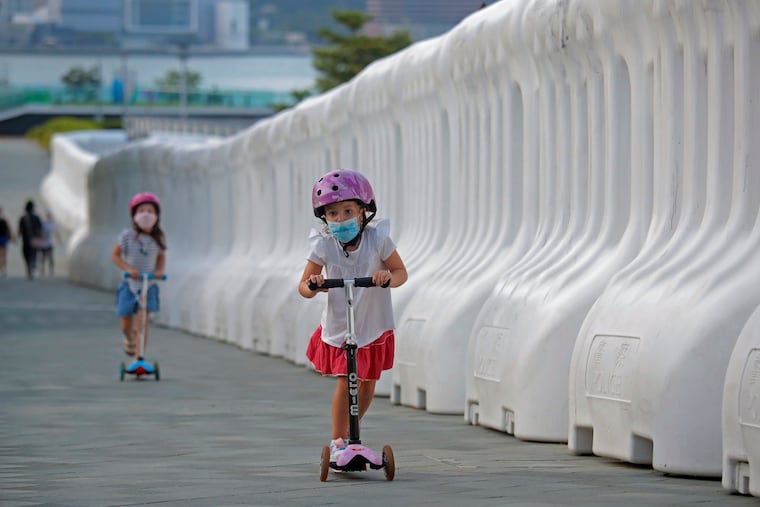New COVID-19 cases keep rising in Philly area, including among Montco hockey players
Infectious disease specialists said the trends are dangerous, and experts fear worse is to come. “The numbers are rising and we in infectious disease and public health are trembling,” on expert said.

The coronavirus pandemic continued to escalate across the nation and the region Wednesday as New Jersey reported its highest one-day total of new cases since early May, and Pennsylvania was close to peak levels as well.
In New Jersey, the state Department of Health reported 2,472 new confirmed COVID-19 cases Wednesday, the highest one-day total since early May.
The Pennsylvania Department of Health, meanwhile, reported 2,795 additional positive cases of COVID-19, bringing the statewide total to 217,666. Daily increases are now even higher than in the springtime peak. Philadelphia alone announced 399 more confirmed cases, bringing the total to 45,981.
One local outbreak reported Wednesday involves a cluster of 23 cases across eight ice hockey teams in Montgomery County.
The national daily case total surpassed 100,000 new confirmed cases Wednesday, the Washington Post reported. And a USA Today analysis found that 21 states, including Pennsylvania, have set records for new cases in a week.
Even so, exit polls conducted by Edison Research found that the pandemic was not the key issue for most Americans voting in the presidential election. The economy was a bigger concern especially for Trump voters, while Biden voters were somewhat more likely to mention the pandemic.
William Schaffner, an infectious-diseases specialist at Vanderbilt University Medical Center, said in an interview with The Inquirer on Wednesday that the trends are dangerous, and experts fear worse is to come. “The numbers are rising and we in infectious disease and public health are trembling,” he said.
The country seems to be split between careful people and carefree people who are not embracing masking and social distancing, he said, and changing attitudes will be difficult. Meanwhile, he said, “the virus is spreading in an uninhibited fashion over most of this country today.”
COVID-19 on the ice
Montgomery County officials are investigating a coronavirus outbreak among ice hockey teams that led to 23 cases across eight teams, Val Arkoosh, chair of the Montgomery County Board of Commissioners, said at a news conference Wednesday.
This outbreak started with three adult ice hockey teams that play at Hatfield Ice Arena or at the Oaks Center Ice, then spread to three different adult teams and five junior teams coached by some of the infected adults. There may yet be more positive cases, Arkoosh said. Officials have found that a “common thread” among these nearly two dozen cases is “the lack of mask-wearing and social distancing, particularly on the bench.” More than 70 close contacts of those 23 cases are now in quarantine, Arkoosh said.
Montgomery County announced an additional 131 cases of the coronavirus and two more people who have died, bringing the county’s total to 14,346 cases and 842 deaths. “Please take this increase in case numbers seriously,” Arkoosh said. “We are already starting to see a rapid increase in hospitalizations.”
Arkoosh, who is a physician, also used the opportunity to caution anyone planning a Thanksgiving meal that would include guests outside the immediate family. Even a small indoor dinner, with 10 to 12 people from a few different households, would fall into the “high risk” category. “I would certainly ask people to really think twice about doing something like this,” Arkoosh said.
Rates rising fast among youth
Children and teens make up a small but steadily growing proportion of COVID-19 cases in the United States, according to the latest weekly report from the American Academy of Pediatrics. which collects data from the 49 states that publish it. More than 61,000 new cases were reported among children and teens in the week ending Oct. 29 — the highest number since the pandemic began.
Cumulatively, over 853,000 youngsters have tested positive for COVID-19 since the pandemic began. While that’s only 11% of all cases, the rate has risen alarmingly. In early June, there were 111 cases per 100,000 youngsters. At the end of October, the rate was tenfold higher, at 1,134 cases per 100,000 children.
Eleven states reported that 15% or more of all their cases in the last week of October were youngsters.
Hospitalizations and deaths among youngsters are uncommon, the AAP report shows. And the report does not distinguish between children and teens — many states (including Pennsylvania and New Jersey) provide age breakdowns – and teens are more likely to get infected than young children.
A heavy toll for Black, Latino workers
From the start of the pandemic, it’s been apparent that essential workers, especially people of color, have borne an uneven burden. A new Rutgers University study found that early in the pandemic, Black and Latino hospital workers were twice as likely as whites to become infected with the virus.
The authors also found that technicians, food service workers, and other support staff were more likely than doctors and nurses to have been infected from April 28 to June 30.
The two trends were related, as Black and Latino workers were more likely to work in those support jobs at Robert Wood Johnson University Hospital in New Brunswick, where the study was conducted. But the higher risk for people of color held true independent of job description, said Reynold A. Panettieri Jr., one of the authors and a professor at Robert Wood Johnson Medical School.
While some of the infections may have occurred outside the hospital, authors said that early in the pandemic, people in support jobs may have had less access to protective equipment.
“These health-care worker heroes aren’t the ones that get the press,” he said. “But truth be told, they were really frontline individuals who made a difference and may have suffered the consequences.”
Staff writers Ellie Silverman and Stacey Burling contributed to this article.